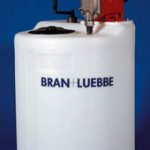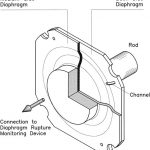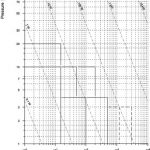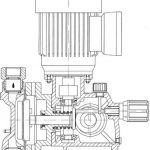Leaks caused by the rupture of membranes in diaphragm metering pumps must be avoided at all costs, both for production and environmental reasons. This generation of isotropic PTFE double diaphragms, in combination with appropriate diaphragm rupture indication systems, has proved to be extremely effective in low-pressure metering processes.
Prof. Dr.-Ing.habil. Rudolf Prager, Dr.-Ing. Thomas van Hamme
In applications with low operating pressures (below 20 bar), the diaphragm pumps normally used have diaphragms which are activated directly in a mechanical fashion by means of a rod. This means that a hydraulic medium is not necessary for support purposes or for activating the diaphragms. The design of such metering pumps is extremely simple and also eliminates the risk of the metered medium becoming contaminated with buffer liquid, e.g. hydraulic oil, in the case of diaphragm rupture.
The diaphragms must have very good stability values, so that the pump can work as independently of the operating pressure as possible. A special production process, based on a multilayered sandwich design, can endow PTFE double diaphragms with isotropic material properties with a homogeneous structure and symmetrical tensile behaviour. This results in optimised reversed bending behaviour, giving the diaphragm an extremely long service life. The metering pump manufacturer can thus give a two-year guarantee on the service life of the diaphragms, which corresponds to up to 17,000 operating hours or 1.5 x 108 load alterna-tions.
The extremely low cold flow of this PTFE material permits high compression in the clamping areas for hermetically sealing the pump head off from the environment. The diaphragm concept, with just two foil layers one inside the other, permits the use of particularly thick individual diaphragms, so that the latter cannot be folded back in the active bending zone in the event of great suction heights. Undesirable diffusion processes when gaseous media are metered can also be effectively dealt with thanks to the optimised thickness of the chemically resistant PTFE diaphragm. The temperature of the metering medium can be from 0 °C to +80 °C and the viscosity up to 1000 mPas.
Function monitoring
In contrast to comparable diaphragm systems with diaphragm rupture indicators, the signal channel needed for recognising damage in the special double diaphragms is integrated directly in the surface of the rear safety diaphragm (Fig. 2). An intermediate element, e.g. a slotted foil, is thus superfluous, meaning that the contact wear in the bending zone, which depends on the number of layers, is minimised and consequently the service life of the diaphragm is extended. There are three alternative ways of monitoring diaphragm ruptures :
• A hose stem for controlled discharge of leaks after a diaphragm rupture.
• A pressure gauge for optical monitoring.
• A pressure switch for transmitting an electrical signal (also with explosion protection).
These are all the functions required for permanent monitoring of the pump, even in automated processes. In the case of a diaphragm rupture, the plant operator has sufficient time to continue the metering process without interrupting it, and does not have to carry out the very simple replacement of the diaphragm until a suitable time arises.
The pump heads fitted with this special double diaphragm are available in seven different sizes and three different materials: rigid PVC, polypropylene and stainless steel (1.4571/1.4581). The hermetically sealed pump heads are fitted with either ball or one valves, depending on the flow rate required.
Robust drives
Th flow rates range from 5 l/h (at 20 bar) to 3000 l/h (at 3 bar), as shown in the performance chart (Fig. 3). These pump heads can in principle be driven by all types of gear which create an oscillating movement. Tried-and-tested spring-cam gears are used for the pumps in the ProCam series for flow rates up to 500 l/h and an effective capacity of approximately 60 W (Fig. 4). In this case, the displacer (diaphragm) is set in oscillating motion by a rod via a cam. The reverse movement of the rod during the suction stroke activates a pressure spring, which rests on the housing and is then bent during the pressure stroke. The prestressing of the spring minimises any play in the gear, which has a positive effect on the metering error of the pump. The maximum stroke of the rod when there is a full frictional connection between the cam and the rod corresponds to twice the eccentricity. With a partial stroke setting, an adjustable stopper prevents the rod from following the cam as a result of the power of the spring, so that only part of the stroke is used for the metering process. This is the phenomenon that is often referred to as a “lost motion gear”. This kinematic process has the disadvantage that in partial stroke operation the displacer system is subject to a shock-like load at the beginning of the pressure stroke, which increases in line with the size of the machine, the effective capacity and the operating angle. More severe jerks also develop in the pressure piping of the pump at the beginning of the metering process and in the suction piping at the end of the suction process. This negative consequence restricts the effective capacity of the spring-cam gear. Up to a flow rate of 500 l/h, pressure fluctuations caused by shock-like accelera-tion of the liquid masses in the piping can be controlled by means of a suitable design for the piping system.
Conventional slider-crank mechanisms, such as the gears in the ProZet series, are used for higher flow rates because of the more favourable kinematic conditions. With these gears the stroke length is adjusted by means of a sliding, oblique crankshaft. This means that the amplitude of the stroke movement changes linearly, so that even in partial stroke operation metering can be performed harmoniously without excessive pulsations.
However, this gear design is technically more complicated and less compact than spring-cam gears. Pump heads with mechanically actuated diaphragms are limited in the diaphragm deflection to stroke lengths of only a few millimetres. Consequently, even at low operating pressures, there are relatively high crosshead forces or bearing loads in the gears compared with hydraulically driven diaphragm pump heads. Crosshead forces, especially in slider-crank mechanisms, are crucial to the size of the pump and thus to the manufacturing costs.
For continuous low-wear operation
All gears manufactured by this company have worm-wheel gear reduction and permit direct attachment of the full range of standard motors often required in industrial applications. The grey cast-iron construction ensures excellent stability. The paint used for the housings, which can also be ordered to suit the customer’s specific requirements, provides good corrosion resistance. Reliable splash lubrication ensures optimum condi-tions for continuous low-wear operation. All gears can be operated with a variable number of strokes in the range from 100% to 20%. Frequency converters and appropriately designed motors are available for such operations. In addition, the stroke length of each pump can be adjusted. This means that, even if several pumps are combined, the relationship of the individual flow rates to one another can be varied independently of the speed of the driving motor.
Of course, the stroke length can also be ad-justed using electrical actuators. However, using frequency converters to change the stroke frequency in a single pump is often a less expensive alternative. On the other hand, electrical stroke length adjustment is the only way to achieve automated flow rate adjustment in conjunction with recipe metering with interlinked gears. In this connection, a special feature of the pumps in the ProCam and ProZet series is the fact that the pump stroke length can also be adjusted when the driving motor is not running. Additional options, such as a pulse generator and an electronic controller either mounted externally or incorporated in the electrical stroke-adjustment actuator, permit optimum integration of all pumps in the ProCam and ProZet series in highly automated industrial plants.
Bran + Luebbe
Fax: ++49/40/5 22 02-444
Further information cpp 236
Unsere Webinar-Empfehlung
Der Webcast MTP und modulare Produktion bietet eine einzigartige Gelegenheit, mehr über die aktuellen Entwicklungen bei MTP und in der modularen Produktion zu erfahren.
Chemie- und Pharmaproduktion braucht mehr Flexibilität
In der heutigen sich schnell wandelnden Welt stehen…
Teilen:














